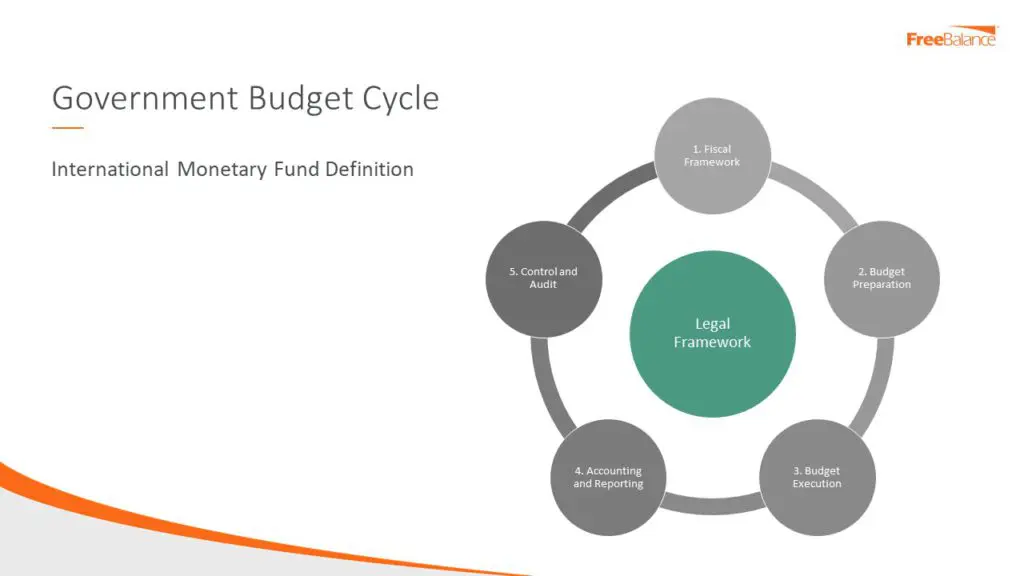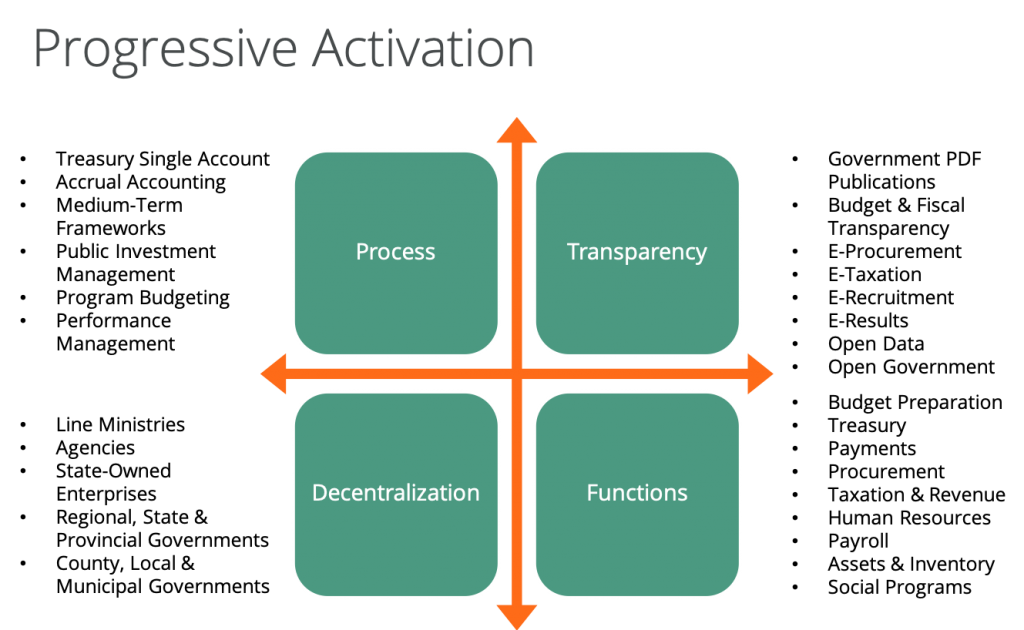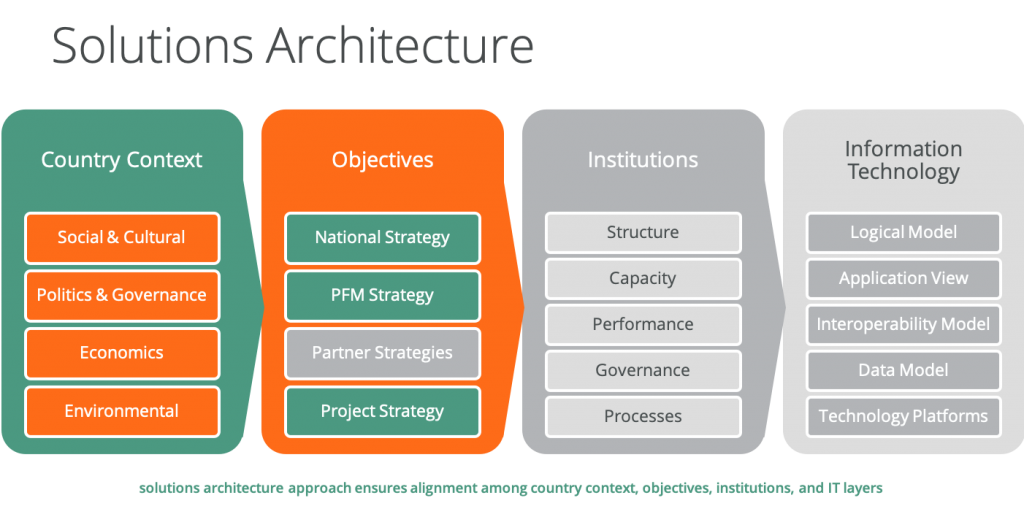Updated March 2022
How Does FreeBalance Help Governments to Sustain PFM Reform?
Governments acquire Government Resource Planning (GRP) software such as the FreeBalance Accountability Suite™ and other Financial Management Information System (FMIS) systems to support Public Financial Management (PFM) reform. However, many governments lose reform momentum and the quality of public finance stewardship stagnates. This stagnation prevents governments from achieving its national development strategy objectives. It’s a situation experienced by some FreeBalance customers, and by many customers of other solutions.
That’s why FreeBalance offers a Medium-Term Sustainability Framework service. This service is available to any government looking to sustain the PFM reform journey.
Why a Medium-Term Perspective?
Although the approval of the annual budget law remains the key step in which important decisions on budgetary policy are adopted, most fiscal measures have budgetary implications that go well beyond the usual yearly budgetary cycle(1). As a result, a single year perspective provides a poor basis for sound fiscal planning. Therefore, the use of Medium-Term Budget Frameworks (MTBFs) is an internationally recommended good practice and often part of a government’s PFM reform plans.
What is a Medium-Term Budget Framework (MTBF)?
MTBFs allow governments to extend their fiscal policy making horizon beyond the annual budgetary calendar. They reflect the impact of past budgetary commitments as well as the future cost of new policy measures.
MTBFs usually cover the preparation, execution, and monitoring of multi-annual budget plans and contain both expenditure and revenue projections as well as the resulting budget balances(2). They are often integrated with more granular tools for fiscal calculations, expenditures, performance, and sectoral strategies.
Medium-term budgetary objectives included in a MTBF are not binding targets. However, they enable fiscal discipline by highlighting the future impact of current policies on the government’s balance sheet. A MTBF also enhances monitoring by providing benchmarks against which budgetary developments can be assessed over time(3).
What are the Benefits of MTBFs?
One of the most important elements of PFM reform is improved support for MTBFs. However, the challenge that governments face is how to operationalize this MTBF good practice within the context of PFM reform.
The benefits of MTBFs include:
- Achieving government fiscal sustainability
- Improving the timeliness and quality of information for decision-makers
- Sequencing reform and budget formulation structures based on the country context
- Adjusting reform approaches based on risk management and mitigation
- Integrating reform with institution through progressive activation
- Modernizing supporting technology architectures and functionality, particularly for FMIS
- Improving international assessments like Public Expenditure and Financial Accountability (PEFA), Public Investment Management Assessment (PIMA), Tax Administration Diagnostic Assessment Tool (TADAT), Debt Management Performance Assessment (DeMPA), and Open Budgets Index (OBI)
- Justifying the use of country systems by donors and country ownership over reform
What is the Medium-Term Sustainability Framework?
The FreeBalance Medium-Term Sustainability Framework (MTSF) enables governments to operationalize MTBF and PFM reform initiatives. It covers all PFM domains across the government budget cycle.

The PFM domains include:
- Government Performance Management: performance management, budget formulation, transparency portals, audit
- Public Financials Management: core commitment accounting, project management, fixed assets, fleet management, inventory
- Public Expenditure Management: purchasing, procurement, grants, social programs, contracts, public investments
- Government Treasury Management: cash, debt, financial investments, liquidity management
- Government Receipts Management: tax and non-tax revenue
- Civil Service Management: human resources, payroll, pensions
Challenges to PFM Reform Sustainability
Governments are often unable to maintain a needed trajectory and cadence for PFM reform. Symptoms include:
- Lack of progress from reform fatigue or attempting to consume more reform than is reasonable in the government circumstances
- Push reform from international donors that might not be appropriate for the government circumstances
- Country systems bypassed by international donors which limits progress for one of the most important outcomes from PFM reform, namely budget, spending and results integration by leveraging country systems
- Poor sequencing of PFM reform based on international assessments rather than what is appropriate for the government context
- Technology limitations that make legitimate reform difficult because of highly customized code bases that were not designed for multiple modernization phases
Reform sustainability hinges on aligning with the country context. Few countries with relatively low levels of development have achieved high and very high development status in the modern era. Successful and prosperous growth has only come when countries have led development by charting prosperity paths that are appropriate to the social, economic and cultural context. These countries changed from the traditional “push model” of country development to a “pull model”.

What are the Financial Barriers to PFM Reform Sustainability?
The implementation of financial software is often not financially affordable for governments. The portfolio of software used can have a high Total Cost of Ownership (TCO). This situation is far beyond software license and maintenance costs. The largest contributors to post-implementation costs are: code customization, technology upgrades, user support, staff training and retention.
Information technology financial sustainability limitations compound technology reform sustainability limitations. These include:
- Complex software adaptability to support changes quickly and easily, typically only available through expensive and error-prone code customization
- Poor system performance to support core functions reducing user efficiency and effectiveness
- Limited disaster resilience to data centre and connectivity problems lowering user availability
- Sub-optimal cybersecurity with external hacking and internal public service corruption resulting in high costs to governments
- Limited automation of financial functions and interoperability among systems increasing unnecessary manual work and generating errors
- High support costs for legacy systems with antiquated technology and proprietary languages
What is the FreeBalance Sustainability Mission?
FreeBalance provides the most financially sustainable GRP software for PFM reform. This mission extends beyond the FreeBalance Accountability Suite™ to include 3rd party software, and advisory services.
Many governments publicly open vendor bids or transparently share the winning bid. FMIS implementations are turnkey solutions requiring application software, middleware, implementation, training, and support services usually for a five-year period. The five-year TCO for FreeBalance GRP is roughly half that of COTS ERP. Costs experienced by governments for ERP or custom-developed solutions tend to be much higher than GRP post implementation.
What is Technology-Enabled PFM Reform?
Progressive activation is the ease of PFM reform adaptability in government financial systems. This includes process modernization, decentralization support, fiscal transparency initiatives, and functionality extension.

What is the MTSF Customer-Centric Approach?
The ability to overcome technology limitations to reform is supported through built-in configuration and ease of product extension in the FreeBalance Accountability Suite™. However, governments have a wide range of software solutions to support budget cycles. It is our mission to leverage capabilities in all underlying systems to support progressive activation. We do not seek to “rip and replace” software. Rather, we leverage our technology expertise as an Independent Software Vendor (ISV) and our PFM technical expertise from 37 years of exclusive work with governments to find solutions for reform.
We call our customer-centric approach “customers for life”. Governments benefit from FreeBalance PFM and technology advice beyond the scope of the software we provide.
Why is a Solutions Architecture a Critical MTSF Deliverable?
FreeBalance MTSFs use a government-centric approach. We do not start with a portfolio of products and services to map to government requirements. We start with the government context through analysis, workshops, and the development of solutions architectures.

The FreeBalance Solutions Architecture includes:
- Country Context analysis using over 400 sources of information about economics, environmental, social-cultural, politics and governance with additional country-specific research by FreeBalance PFM experts
- Objectives Context analysis using national development strategies, country visions, budget objectives, PFM assessments and strategies, development partner and existing project strategies
- Institutional Context analysis examining structures, capacity, performance, governance and legal requirements, formal and informal processes
- Information Technology analysis of underlying systems supporting PFM considering logical models, software applications in use, system interoperability, data models, and technology platforms
Who Would Benefit from FreeBalance’s MTSF Service?
The MTSF is offered to any government finance or planning ministry.
What is Included in the MTSF Service?
As a minimum, a MTSF consists of:
- Solutions architecture
- PFM reform plan spanning three to five years, depending on the context
- Estimated budget for each year
- Performance objectives
FreeBalance can act as the advisor to ministries for reform project management involving internal government and external consultants. FreeBalance can also provide a prime contracting role.
What Tools Does FreeBalance Leverage for MTSFs?
FreeBalance leverages over 200 templates for advisory, implementation, and sustainability services. Although considered a FreeBalance sustainability offering, MTSFs leverage a number of advisory and implementation services tools that are part of the FreeBalance government-specific A-i3+qM™ methodology. Many of these tools have been in use for years.
